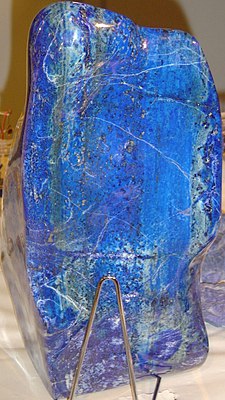The modern English word blue comes from Middle English bleu or blewe, from Old French bleu, bleve, blöe, a word of Germanic origin (Frankish or possibly Old High German blāo, "pale, wan, blue-grey").
Blue is associated in Christianity generally and Catholicism in particular, with the Virgin Mary.
Blue in Hinduism: Many of the gods are depicted as having blue-coloured skin, particularly those associated with Vishnu, who is said to be the Preserver of the world and thus intimately connected to water. Krishna and Ram, Vishnu's avatars, are usually blue. Shiva, the Destroyer, is also depicted in light blue tones and is called neela kantha, or blue-throated, for having swallowed poison in an attempt to turn the tide of a battle between the gods and demons in the gods' favour.
Blue in Judaism: In the Torah,[18] the Israelites were commanded to put fringes, tzitzit, on the corners of their garments, and to weave within these fringes a "twisted thread of blue (tekhelet)".[19] In ancient days, this blue thread was made from a dye extracted from a Mediterranean snail called the hilazon.
 Maimonides claimed that this blue was the colour of "the clear noonday sky"; Rashi, the colour of the evening sky.[20] According to several rabbinic sages, blue is the colour of God's Glory.
Maimonides claimed that this blue was the colour of "the clear noonday sky"; Rashi, the colour of the evening sky.[20] According to several rabbinic sages, blue is the colour of God's Glory. According to several rabbinic sages, blue is the colour of God's Glory.[21] Staring at this colour aids in mediation, bringing us a glimpse of the "pavement of sapphire, like the very sky for purity", which is a likeness of the Throne of God.[22] (The Hebrew word for glory.)
According to several rabbinic sages, blue is the colour of God's Glory.[21] Staring at this colour aids in mediation, bringing us a glimpse of the "pavement of sapphire, like the very sky for purity", which is a likeness of the Throne of God.[22] (The Hebrew word for glory.)Blue in Islam: the colour blue is mentioned in the Quran: In verse 20:102
"The Day the Horn will be blown. And We will gather the criminals, that Day, blue-eyed."
Blue amulets made of lapis lazuli are commonly utilised to symbolise luck in some Muslim cultures.

- lapis lazuli

- early 15c., from M.L. lapis lazuli, lit. "stone of azure," from L. lapis "stone.
tints of blue
Periwinkle (color)
Powder blue
Baby blue
a blue flag on the side of a locomotive means that it should not be moved because someone is working on it (or on the train attached to it).
No comments:
Post a Comment